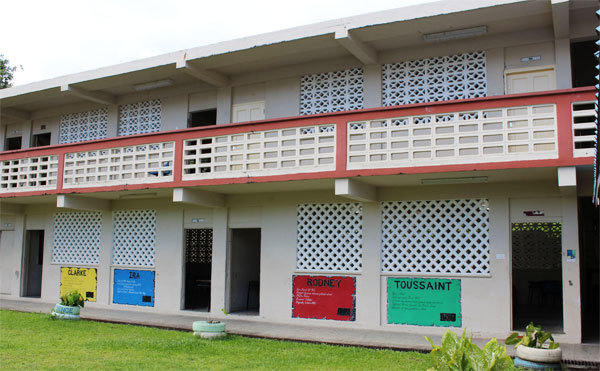
RECENTLY, the new Principal of Sir Arthur Lewis Community College spoke on the poor condition of the buildings and the fact that it was now at the point where classes had to be relocated.
The Weekend Editorial of The VOICE expressed concerns on the neglect in the education sector and referenced a previous publication of the condition of the Soufriere Comprehensive School. The Editorial continued by asking a series of questions;’’ What went wrong with our education system?” Was anyone monitoring conditions that were clearly deteriorating before their eyes? Was the Ministry of Education aware? Was the Minister? Was the Ministry of Infrastructure which we are told had responsibility for schools? Was that Minister? Or is this the case where everyone with oversight of the school plant slept on the job?”
All the questions are valid and should be answered. Just next to that editorial was a view expressed by the present Minister of Education – Hon Dr. Gale Rigobert in which she stated: “I understand that at the last fiscal cycle, when the audit of schools infrastructure was done, the total estimated cost of rehabilitation hovered around $ 13.0 Million while the amount allocated in the 2016/17 budget was $ 1.0 Million.”
In a casual recent conversation I had with Mr.BishnuTulsie, he advised that the problems at the Castries Comprehensive School existed during the time he was a teacher there. He left over 20 years ago.
So let us begin to answer some of the questions posed by the Editor of the VOICE. Was anyone monitoring the conditions that were clearly deteriorating before their eyes? – YES. Was the Ministry of Education aware? – YES. Was the Minister of Education aware? – YES. Was the Ministry of Infrastructure aware? – YES. Was the Minister of Infrastructure aware? – YES. Thus the last question is the key to understanding the problem- WHAT WENT WRONG WITH OUR EDUCATION SYSTEM?

For the last 40 years, school buildings have been seen as a political accomplishment. A Member of Parliament believed that the establishment of a school in his constituency was a sign to his constituents of an expression of care. The same holds for Police Stations, Fire Stations and Health Centres. The government is thus now the owner of the largest stock of buildings in Saint Lucia. Let us extract the schools to observe what went wrong. Saint Lucia’s Education system functions with 90 Primary schools and 23 Secondary schools. Of the 90 primary schools, there are three private schools which are all in the North of the island, one Methodist, six Roman Catholic, two Anglican and three Adventists. I know that there is some arrangement with the churches to assist in maintenance of schools, so we can conservatively say that maintenance of over 80 primary schools, 23 secondary schools and one tertiary school will be the responsibility of the government.
If one observes the number of students who sat the Common Entrance exams in 2016, the ‘what went wrong’ begins to emerge. In one school, five students sat Common Entrance, another school had 8 students, another 9. If we say that an acceptable class size is 30 students and we examine the schools, it is observed that 42 schools have less than 30 students sitting Common Entrance. If we then say that an acceptable school size is two classrooms per Grade or 60 students doing Common Entrance, and then the statistics get more interesting, there will be 60 schools that will not reach that threshold.
Undoubtedly, we have to take a bold and decisive position on the amalgamation of schools and to create an efficient school transportation system that supports these new clusters. We had 2419 students sitting the Common Entrance exam from 90 schools and thus we have an average enrolment of 27 students per school. Another way of expressing this statistic is to say that we have an average of ‘one classroom’ schools in Saint Lucia. There is thus no mystery in the problems we face in maintenance of this stock of buildings.
Assuming all the Common Entrance students go to secondary school, then we have 2419 students going to 23 secondary schools, giving an average of 105 students per form. Thus in an ideal situation the number of secondary schools should equate the number of primary schools in a universal secondary school system. Let us do some mathematics, if the area of St Lucia is 238 sq. miles and say 30 % is uninhabited, and we limit the placement of schools to a two mile radius, 23 primary schools will be more than able to achieve that objective, this is assuming a smooth spread of population.
The fact remains that amalgamation of school has to be considered as a policy going forward and some primary schools should be closed down and converted to adult learning centres managed by the private sector. The stark reality is that Saint Lucia cannot afford to maintain its present stock of over 100 public schools, and we have to be decisive in taking proactive decisions to reduce that number.














There are alternatives. By going online there is a huge cost saving. It is more democratic. It becomes more inclusive. There is more choice. It is more accessible and it is cheaper and more affordable after the technical infrastructure of the learning platform has been contracted.
UWI is inviting outside institutions to eat its supper with potential substantive inroads being made into is natural reservoirs or pools of potential undergraduates. Wake up. Without this change UWI will become marginalized with nice empty refurbished buildings, but few students to recover the outlays, capital and recurring expenditures. UWI and Saint Lucia is way behind the curve on this one.
There are alternatives. By going online there is a huge cost saving. It is more democratic. It becomes more inclusive. There is more choice. It is more accessible and it is cheaper and more affordable after the technical infrastructure of the learning platform has been contracted.
UWI is inviting outside institutions to eat its supper with potential substantive inroads being made into is natural reservoirs or pools of potential undergraduates. Wake up. Without this change UWI will become marginalized with nice empty refurbished buildings, but few students to recover the outlays, capital and recurring expenditures. UWI and Saint Lucia are way behind the curve on this one.
Weak people always want strong people to do something for them.
Get up and walk, beggars.
Tony,
You seem to be the only nice man. Thank you for suggestion.